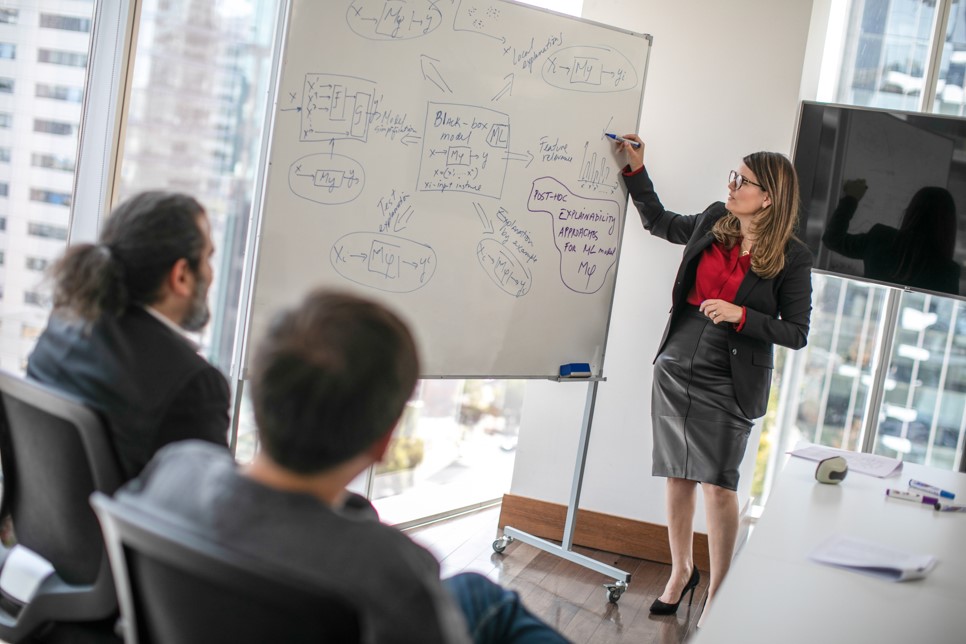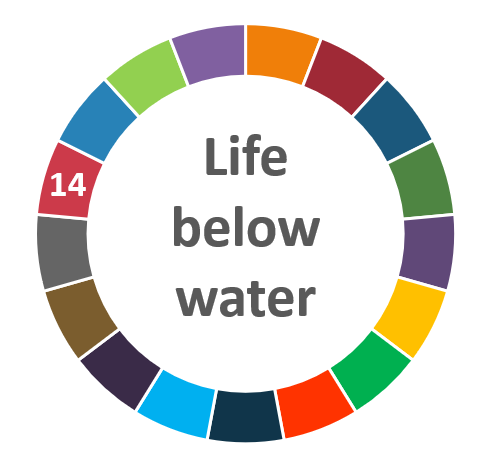
ΑΙhub.org
Interview with Nayat Sánchez-Pi – how the OcéanIA project is advancing our understanding of the oceans and our climate

Nayat Sánchez-Pi is the Director of the Inria Chile Research Center. We asked her about her research and about the OcéanIA project which she leads. The aim of the OcéanIA project is to develop new artificial intelligence and mathematical modeling tools to contribute to the understanding of the oceans and their role in regulating and sustaining the biosphere, and tackling climate change.
Could you tell us how you got into this area of research and why you find it interesting?
I have been working in the area of artificial intelligence and machine learning for more than 15 years now. During this time I have always had an interest in finding ways of taking the state-of-the-art of my area of research and applying it to have a direct impact on the real world. The project OcéanIA gives the perfect opportunity for doing this. On one hand, it has the potential of becoming our humble contribution to the wellbeing of humanity. On the other hand, it poses many interesting challenges for computer science and applied math and, therefore, it is also very intellectually appealing from that point of view.
What are the main challenges in the field of AI and the oceans/climate at the moment?
There is strong scientific evidence about the impact of climate change on the global ocean and vice versa, and the potential healing effect of the global ocean as regulator and mitigator of climate change. In particular, there is a clear scientific consensus about the possible consequences of climate change, i.e. a shift of temperatures, an increase of acidification, deoxygenation of water masses, and perturbations in nutrient availability and biomass productivity. Altogether, these abiotic changes will have a drastic impact on almost all forms of life in the ocean with further consequences on food security, ecosystem services and the well-being of coastal communities.
The intertwining nature of these two problems requires that to address the first it is necessary to make progress on the second. These can be said to be the main challenges that we face when applying AI in this context.
The challenges are two-fold: on the one hand, we must understand the consequences of global warming for ocean ecology, and on the other hand, we must be able to predict changes in climate from observations of the same systems, where a key actor is biodiversity. Moreover, our prediction abilities have direct consequences on many economic systems and public policies. Essential to these efforts is our ability to make sense and integrate heterogeneous, incomplete and cross-scale data, ranging from genomics to satellite images in different environmental settings, tasks for which machine learning and artificial intelligence at large, and mathematical modeling, are especially suited and powerful if a virtuous relationship between them is achieved.
Our motivation here is to develop new AI and mathematical modeling tools to contribute to the understanding of the structure, functioning, and underlying eco-evolutionary mechanisms and dynamics of plankton in the global ocean. Methods like deep learning, causal and inference learning, sequential decision making, transfer learning, multi-criteria optimization are just a few that can be applied to these kinds of complex problems, allowing us to get reliable knowledge from the ocean and its interactions.
Regarding the OcéanIA project: what kind of problems are you investigating with the team?
Ultimately, with OcéanIA we want to answer three key questions of increasing importance, that is to understand how the ocean mitigates climate change, how climate change affects the mitigation capacity of the ocean, and what actions or policies should be implemented to protect and foster that capacity. These are big questions and to address them we have decided to split these questions into smaller problems that should be easier to tackle. For instance, we are understanding the relationships between biodiversity and ecosystem functions and the impact of biogeochemical cycles on biodiversity. We are also applying AI to understand plankton communities from microscope images, connecting those images to genomic features and relating them to satellite images, and, eventually we will apply anomaly detection to automatically identify new species of plankton.
Is there a particular aspect of the OcéanIA project that you are most excited about?
It is hard to pick one of the problems as the most interesting one. Actually, what I find most exciting is that with the combination of the results of OcéanIA we can have an actual contribution to understanding and mitigating climate change.

How can AI help researchers in this field in ways that other methods can’t?
AI, machine learning, and mathematical modeling are key in understanding oceans and climate change as other descriptive tools have important hurdles in their application. Furthermore, “regular” machine learning also does not work as this particular problem calls for state-of-the-art solutions. Moreover, the goals that we plan to address are not limited to modeling or describing the reality, actually we want to generate new scientific knowledge and, for that, we need sophisticated AI/machine learning methods like causal inference, explainable AI, structured-based neural networks, transfer learning and domain adaptation, among others.
In your keynote talk at NeurIPS 2020 (AI, Oceans and Climate Change) you mentioned the Tara Oceans expedition, which sounds very interesting! Could you tell us a bit about how this is going?
Yes, the expedition Tara Microbiome-CEODOS! The objective of this new expedition is to study the marine microorganisms which play a fundamental role in ocean ecosystems. These microbiomes are key players in regulating the health of our planet. The Tara Ocean Foundation is carrying out this expedition that unites the Atlantic, Southern and Pacific oceans in a single two-year campaign (2021-2023). Tara schooner sailed from Lorient in December 2020 and arrived in Chile in February 2021. Tara, in conjunction with a consortium of nine Chilean institutions, including Inria Chile, supports this mission to sample the entire Chilean coast between February and April 2021.
We are very happy, they already sampled the waters of Punta Arenas, Puerto Montt, Concepción, Valparaiso and this week it will arrive at Iquique, which will be the last stop in Chile.
What data is being collected, and how is it being used?
Tara does what is known as “stations” where they carry out a set of samples. Tara is collecting metagenomic and microscopy at three depths per station and using filters that distinguish up to five sizes of organisms (from viruses to crustaceans), emerging pollutants such as microplastics, pathogens, and trace metals, and capturing real-time greenhouse gas and satellite data. These samples have their DNA sequenced and are examined by a microscope to get images of the microorganisms.
This data is then shared with the scientific community. Different scientists are interested in different aspects of it and use it for different purposes. For instance, for us the main questions to be addressed are:
- Which are the major patterns in plankton taxa and functional diversity?
- How will these patterns and drivers change as a result of climate change?
- How will these changes affect the capacity of ocean ecosystems to sequester carbon from the atmosphere, that is the biological carbon pump?
- What are the links between biodiversity functioning and structure?
- How can modern AI and computer vision be applied as research and discovery support tools to understand planktonic communities?
About Nayat Sánchez-Pi
Nayat Sánchez-Pi is the Director of the Inria Chile Research Center. She has a PhD in Computer Science from the Universidad Carlos III de Madrid (UC3M), for which she received the Extraordinary PhD Thesis Award. Since 2015, she has been Professor of Artificial Intelligence and Human-Computer Interaction at the Universidade do Estado do Rio de Janeiro (UERJ), co-leading the Research Group on Intelligence and Optimization (RIO Group). She has also been a researcher at Universidade de Lisboa, University College in Dublin and Universidade Federal Fluminense.
The OcéanIA project
OcéanIA is a four-year project (2020–2024) involving Inria teams in Chile, Paris, Saclay, and Sophia-Antipolis, and the Fondation Tara Océans, the Center of Mathematical Modeling (CMM, U.Chile), the Pontificia Universidad Católica de Chile (PUC), the GO-SEE CNRS Federation, and the Laboratoire des Sciences du Numérique de Nantes (LS2N).
The aim of the project is to develop new artificial intelligence and mathematical modeling tools to contribute to the understanding of the structure, functioning, underlying mechanisms, and dynamics of the oceans and their role in regulating and sustaining the biosphere, and tackling the climate change.
You can find out more about the OcéanIA project here.
AIMOCC workshop at ICLR
Organised by Luis Martí and Nayat Sánchez-Pi, the AI: Modeling Oceans and Climate Change (AIMOCC 2021) Workshop was held recently at the International Conference on Learning Representations (ICLR 2021).
The goal of this workshop was to bring together researchers with an interest in applying AI and ML techniques to problems related to marine biology, modeling, and climate change mitigation. The aim is to build a multi-disciplinary community, with collaborating researchers that share problems, insights, code, data, benchmarks, training pipelines, etc.
NeurIPS talk
Nayat gave a talk at NeurIPS 2020, entitled AI, Oceans and Climate Change, which is available for anyone to watch. Find the recording here.

tags: Focus on life below water, Focus on UN SDGs











